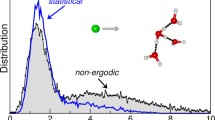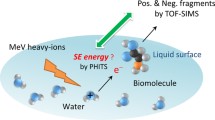Abstract.
Size-selected, protonated water cluster cations (H2O)nH+, 4 ≤ n ≤ 32, are scattered at normal incidence from the surface of a diamond-coated silicon wafer at collision energies 0 ≤ E coll ≤ 500 eV. The size distribution of collision-induced fragment-ions and the ion yield of scattered particles are analyzed, using a secondary time-of-flight mass spectrometer, as a function of the cluster size, n, and the collision energy, E coll. Even at low impact energies only very small fragment-ions can be detected, with a maximum fragment size of ∼35% of the colliding parent cluster ions. For clusters consisting of more than 10 molecules, the protonated water dimer (H2O)2H+ becomes the predominant fragment-ion. The total charge survival yield obeys a nonlinear increase with cluster size; for the largest clusters investigated, more than 35% of the impacting ions survive the surface collision in the cationic charge state.
Similar content being viewed by others
Author information
Authors and Affiliations
Corresponding author
Rights and permissions
About this article
Cite this article
Christen, W., Even, U. Hyperthermal surface-collisions of water cluster cations. Eur. Phys. J. D 24, 283–286 (2003). https://doi.org/10.1140/epjd/e2003-00160-3
Received:
Published:
Issue Date:
DOI: https://doi.org/10.1140/epjd/e2003-00160-3
PACS.
- 34.30.+h Intramolecular energy transfer; intramolecular dynamics; dynamics of van der Waals molecules
- 34.50.-s Scattering of atoms and molecules
- 34.70.+e Charge transfer
- 36.40.-c Atomic and molecular clusters
- 61.46.+w Nanoscale materials: clusters, nanoparticles, nanotubes, and nanocrystals
- 82.40.-g Chemical kinetics and reactions: special regimes and techniques




